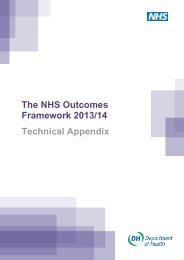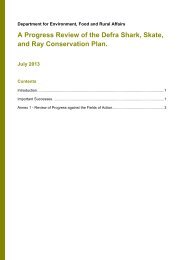A study of Patent Thickets (1.31Mb) - UK Intellectual Property Office
A study of Patent Thickets (1.31Mb) - UK Intellectual Property Office
A study of Patent Thickets (1.31Mb) - UK Intellectual Property Office
Create successful ePaper yourself
Turn your PDF publications into a flip-book with our unique Google optimized e-Paper software.
A Study <strong>of</strong> <strong>Patent</strong> <strong>Thickets</strong> 51<br />
Combining this finding with the clear variability in the proportion <strong>of</strong> entrants choosing specific<br />
technology areas, we see that <strong>UK</strong> firms active in specific product markets change the type <strong>of</strong><br />
technology area they enter over time. Whether this is in response to growing patent thickets<br />
cannot be determined from the descriptive analysis. The econometric results provided in the<br />
following section show this to be the case.<br />
4.3 <strong>Patent</strong> thickets and entry<br />
As we discuss earlier in this report, one <strong>of</strong> the functions <strong>of</strong> the patent system is to allow inventors<br />
to exclude others from practicing their invention. The implication <strong>of</strong> this fact is that in technology<br />
areas where there are large numbers <strong>of</strong> patents, it might be more difficult for new firms to enter<br />
because the technology space is effectively covered by patents held by existing firms. By itself,<br />
this is not necessarily a phenomenon requiring some kind <strong>of</strong> policy intervention, as it is to be<br />
expected if the patent system is doing its job. However, in sectors where firms must draw on<br />
technologies for which their competitors hold patents in order to produce, it is possible that the<br />
presence <strong>of</strong> many closely related patents held by incumbent firms could discourage the entry <strong>of</strong><br />
new firms with novel ideas, because such entry requires negotiating access to a prohibitively<br />
large number <strong>of</strong> other technologies in order to incorporate their invention(s) in a product. As we<br />
review earlier in this report, many researchers have identified sectors based on complex<br />
technologies and technical standards as sectors <strong>of</strong> this kind (Shapiro, 2000; Hall and Ziedonis,<br />
2001; Arora et al., 2008).<br />
In order to capture the idea that some sectors may be characterized by collections <strong>of</strong> patents<br />
held by different firms, but at least some <strong>of</strong> which are jointly required for production, we use the<br />
previously described measure <strong>of</strong> patent thickets developed by Graevenitz et al. (2012, 2011),<br />
henceforth vGWH. The idea <strong>of</strong> this measure, which is based on patent applications to the EPO,<br />
is that it can proxy for the extent to which a sector contains many patents with possibly<br />
overlapping claims. Because it identifies situations where groups <strong>of</strong> firms are applying for similar<br />
patents that potentially block each other, it identifies technology areas where there is active<br />
patenting by existing firms that have strategic relationships with one another. As argued earlier,<br />
such technology areas are usually those where products are also complex and draw on<br />
technologies held by multiple firms. The inquiry we undertake here is whether <strong>UK</strong> firms are<br />
discouraged from entering such technology areas. Therefore we examine the influence <strong>of</strong> this<br />
measure on the probability that a <strong>UK</strong> firm enters a technology sector, where entry is defined as<br />
the priority year <strong>of</strong> the first patent in the relevant technology sector that is applied for at the<br />
European <strong>Patent</strong> <strong>Office</strong> (EPO) or the <strong>UK</strong> <strong>Intellectual</strong> <strong>Property</strong> <strong>Office</strong> (<strong>UK</strong>IPO). The sample we use<br />
for estimation includes all the firms with at least one patent application at the IPO in the <strong>UK</strong> or<br />
the EPO during the 2001-2009 period, along with a random sample <strong>of</strong> non-patenting firms.<br />
The information for <strong>UK</strong> firms is drawn from the FAME database described in the appendix.<br />
Because this database includes all firms, it is very large, and includes mostly non-patenting<br />
firms. We do two things to deal with this problem: 1) we delete all firms in the industrial sectors<br />
that have little patenting (amounting to less than 2 per cent <strong>of</strong> all patenting); and 2) we choose<br />
a one per cent sample <strong>of</strong> non-patenting firms to compare to our patenting firms. 31 The latter<br />
31 Because each <strong>of</strong> the approximately 3 million firms can in prinicple generate 34 sectors*8 years = 272 observations,<br />
we are unable to include the full FAME dataset in our estimation. In practice, we found including the nonpatenters<br />
made little difference to our estimates.

















